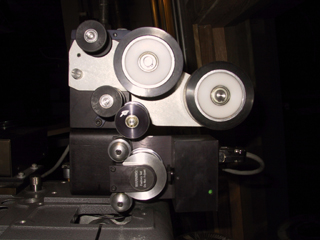|
|
 
|
|
Author
|
Topic: Guess What It Is?
|
|
|
|
|
John Pytlak
Film God

Posts: 9987
From: Rochester, NY 14650-1922
Registered: Jan 2000
|
 posted 10-18-2001 02:01 PM
posted 10-18-2001 02:01 PM





It's a Particle Transfer Roller (PTR) Film Cleaner. The incoming print is looped over the two soft polyurethane PTR rollers, which have a soft and slightly "sticky" surface that removes loose dirt particles from the film surface. The PTRs are cleaned by washing in water or gently removing the dirt buildup with adhesive tape, and are capable of cleaning up to 10 million feet of film. Although PTRs are very effective and safe in removing loose dirt from the print, they can become overloaded if the print is excessively dirty or abraded. PTR cleaners are especially safe, useful, and effective in film cleaning applications where foreign materials cannot be applied to the film (e.g., IMAX, printing negatives, archival materials). IMHO, Joe Redifer's bad experience when he reviewed PTRs was because he tried to clean film badly abraded by the projector, overloading the PTRs. PTRs are successfully used by hundreds of film labs, film-to-video telecines, and theatres (especially special venue). I was the project leader in developing the PTR film cleaning technology for Kodak.
------------------
John P. Pytlak, Senior Technical Specialist
Worldwide Technical Services, Entertainment Imaging
Research Labs, Building 69, Room 7525A
Rochester, New York, 14650-1922 USA
Tel: 716-477-5325 Cell: 716-781-4036 Fax: 716-722-7243
E-Mail: john.pytlak@kodak.com
Web site: http://www.kodak.com/go/motion
| IP: Logged
|
|
|
|
|
|
|
|
John Pytlak
Film God

Posts: 9987
From: Rochester, NY 14650-1922
Registered: Jan 2000
|
 posted 10-19-2001 06:50 AM
posted 10-19-2001 06:50 AM





Joe ---I agree that washing and drying 16 sets of PTRs after every show would be difficult for a single operator. So, many theatres effectively clean the rollers by using adhesive tape to remove the dirt buildup. It takes only a few seconds to "see-saw" a piece of tape over the dirty roller, removing all the dirt particles the PTR took off the print. A quality "low stick" tape like artists or architects tape is best, as it is just sticky enough to remove the dirt, yet not so sticky to risk "plucking" the soft polyurethane of the PTR. Washing PTRs with mild dishwashing detergent and water should still be done occasionally (e.g., once per day, with an overnight to dry), to remove any oil residue picked off the prints and maintain the cleaning efficiency. As I said, I think your "bad" experience with PTRs was because the rollers overloaded with dirt from the severe projector abrasion you were encountering at the time.
------------------
John P. Pytlak, Senior Technical Specialist
Worldwide Technical Services, Entertainment Imaging
Research Labs, Building 69, Room 7525A
Rochester, New York, 14650-1922 USA
Tel: 716-477-5325 Cell: 716-781-4036 Fax: 716-722-7243
E-Mail: john.pytlak@kodak.com
Web site: http://www.kodak.com/go/motion
| IP: Logged
|
|
|
|
Brad Miller
Administrator

Posts: 17775
From: Plano, TX (36.2 miles NW of Rockwall)
Registered: May 99
|
 posted 10-19-2001 01:17 PM
posted 10-19-2001 01:17 PM




PTRs are plain and simple not as effective as a wet cleaning, ideally with a media cleaner, for field use. They appear to be fine for labs and IMAX booths where everything is kept to white glove room quality, but for the typical theater, they are just useless. Even with that being said, I've not seen an IMAX presentation that I did not feel was in need of cleaning."Pristine" condition varies horribly from person to person. What another person thinks is a perfect print is a shit print to me. I've rejected dozens of prints that were ran only one single time at another theater because of damage that was unacceptable to me, but perhaps not even noticeable to other people. I know Joe is also very picky as I am and I've received tons of emails from people telling me that they *thought* they had a great presentation before switching over to media cleaners and FilmGuard. Most people really do not know any better until they see it. Even brand new prints straight from the lab are NOT in pristine condition, I don't care what anyone says, they are not. There is always dirt on them, most times objectionable amounts to me. No doubt a lot of this comes from the clip together reels that the depots use, but regardless my first presentation is always the worst (even though it would be on par with the first presentation of PTR theaters) and mine only gets better from there. The theaters in town that use PTRs have their best presentation on the first day and it all goes downhill from there. This is a repeated decaying pattern of print quality with PTRs. Again, it all just depends on how much you care about achieving a perfect (and I do not mean a "good", but perfect ) presentation. Once someone has tried BOTH properly and according to the instructions, I've yet to hear anyone still side with PTRs. Unfortunately, IMAX prints only have the option of PTR cleaning, which is why I feel the comments from the IMAX guys is out of place here for they can not honestly compare fairly. Also, IMAX is a ridiculously larger frame, which means that each speck of dirt is magnified to a far lesser degree than the typical booths running 35mm prints. Those IMAX comments are very deceptive and do not apply to 99% of the members here.
| IP: Logged
|
|
|
|
|
|
All times are Central (GMT -6:00)
|
|
Powered by Infopop Corporation
UBB.classicTM
6.3.1.2
The Film-Tech Forums are designed for various members related to the cinema industry to express their opinions, viewpoints and testimonials on various products, services and events based upon speculation, personal knowledge and factual information through use, therefore all views represented here allow no liability upon the publishers of this web site and the owners of said views assume no liability for any ill will resulting from these postings. The posts made here are for educational as well as entertainment purposes and as such anyone viewing this portion of the website must accept these views as statements of the author of that opinion
and agrees to release the authors from any and all liability.
|

 Home
Home
 Products
Products
 Store
Store
 Forum
Forum
 Warehouse
Warehouse
 Contact Us
Contact Us




 Printer-friendly view of this topic
Printer-friendly view of this topic















